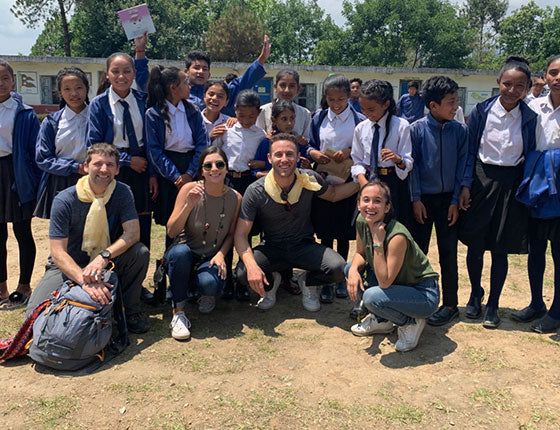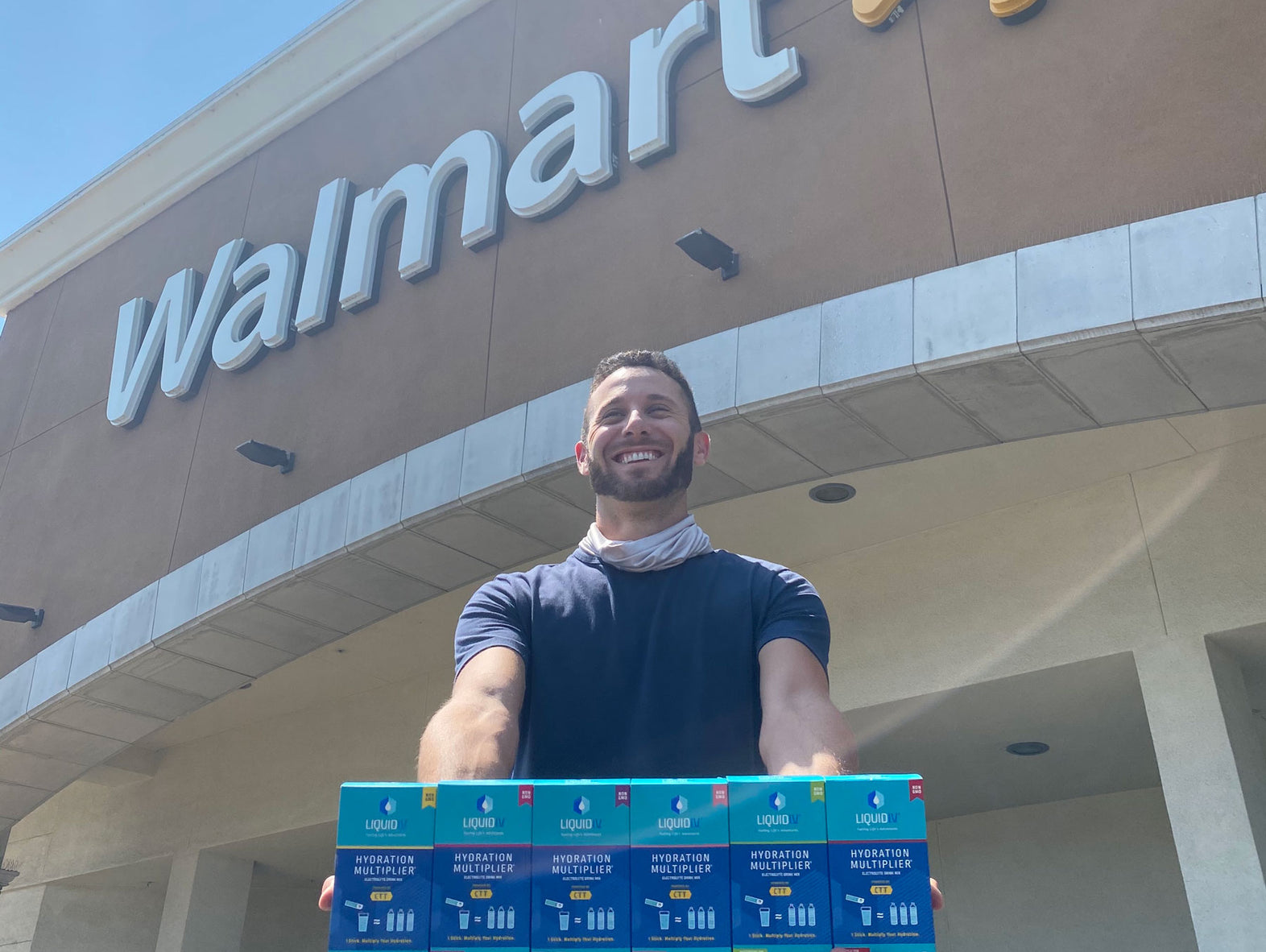
May 12th 3:55 PM
The Liquid I.V. team takes off from LAX. For 16 hours, we chase the sun to the Doha International Airport in Qatar. Our seats are inside sleek rectangular pods that lay flat with the touch of a button. We are offered every luxury: gourmet meals, hundreds of movies and TV shows on a high-definition screen, and a nighttime turn-down service for our seat beds.
We land, and the sun shuffles off ahead of us, leaving Qatar in darkness. We are lucky to have landed at night—it is Ramadan, and public dining is forbidden during the day. We eat our fill in the spacious, luxurious business class lounge at the Doha airport for a 6-hour layover before our flight to Kathmandu.
May 14th 7:45 AM
We land at Tribhuvan International Airport in Kathmandu, Nepal. The contrast between Kathmandu and Doha is extreme. Here, the air is dusty and the unassuming brick building looks old and neglected. Giant foam letters welcome us to Nepal outside the entrance. Behind them sits a statue of a god with wings—a good omen for travelers and a symbol of the spiritual energy of the country. The importance of what we are doing here begins to sink in.
We meet with Daniel Hovey, our Direct Relief liaison, who drops us off at our hotel in the center of historic Kathmandu. Along the way, we witness the chaos of the Kathmandu streets. We see intersections with no traffic lights, constant honking, exposed electrical wires, little boys peddling cotton candy, and cows stopping traffic. Hundreds of cars and motorbikes vie for the street alongside us, all barely avoiding what seem like inevitable traffic accidents. The city itself seems to be hanging by a thread, but even in the chaos, people treat one another with respect.
Our next flight isn’t until the next morning, so Dan introduces us to Dr. Milan Maharjan, founder of Ear Care Nepal, and together we spend the afternoon walking around historic Patan. She tells us about the epidemic of deafness common among Nepali schoolchildren, and about the free surgeries she performs to restore their hearing. She talks about how she never wanted children—how she has always felt compelled to devote her time and attention to helping the children of Nepal. We visit her headquarters, astonished at the difference one person can make, and inspired to do our part to change the world.
May 15th 10:15 AM
We arrive back at Tribhuvan International Airport, and this time we take a turbulent 30-minute propeller plane ride to Pokhara, a city in the center of Nepal populated by trekking tourists and native Nepalis alike. Once there, we meet Dr. Aban Gautam, who founded Mountain Heart Nepal at age 25 after the earthquake devastated the country. His shining spirit and generous nature are evident within minutes. He has brought with him four brilliant young Nepali doctors and three vehicles: sturdy 4 x 4s donated from Direct Relief to help MHN complete medical missions in remote locations. We climb into the cars with all our bags and begin the last leg of the journey to our final destination, where the real work begins.

May 15th, 6:15 PM
We depart Pokhara to drive for 6 hours through bustling cities, which turn into large villages, which turn into rural pastures. We reach the base of the mountain, and then spend the next three hours steadily winding our way up. Our 4x4s prove hardy as we hurtle over the large rocks that litter the dirt road, our heads hitting the ceiling of the car with each bump.
We finally arrive in Ghale Gaun. Almost 40 hours of travel have led to this point, and the sense of accomplishment is felt throughout the team. We are tired, but the people of the village buoy us with their hospitality. We are given yellow scarves to tie around our necks—symbols of appreciation meant for welcome visitors.
The villagers cook thali—a rice dish with garbanzo beans, veggies, and chicken they barbecue themselves, and we eat voraciously. Later, we retire to our hotel rooms. We turn on the lights and dozens of tiny bugs flock to the lightbulb. We turn on the showers: only cold water. Large spiders stand frozen in the corners of the room. The room is barely insulated, and our blankets don’t quite keep out the chill. We try to sleep.
May 16th, 8:00 AM
Despite a challenging night, we wake up exhilarated. We scramble up a small hill early in the morning to see a magnificent sunrise over the Himalayas. Then it’s time to set up the medical camp. The site is an empty preschool with quotes in Nepali on its walls. The only quote in English reads, “Changing the world starts with educated children.” It is deeply meaningful to see the words of our own mission, “changing the world,” reflected here, almost 9,000 miles from home. We gather chairs from a classroom and put them out in the shade—a makeshift waiting room for Ghale Gaun’s sick. We set up a table where we will distribute Liquid I.V. We are trained to take blood oxygen levels and pulse rates.
Soon, the villagers will arrive. They have read about the medical camp in their local newspaper or heard about it on the radio or through word of mouth. Without the medical camp, the village’s sick will have to walk ten hours to get to the nearest doctor, so when a clinic is set up, people are sure to attend.
May 16th, 10:00 AM
The villagers begin to filter in, and we are surprised at the state of many of them. Most people have blackened or damaged teeth from lack of proper dental hygiene and access to dental care. Many have dirty hands and walk stooped from decades of back-breaking work in the rice fields. Plenty of children and elderly have chronic coughs from the extreme amount of dust. Children’s noses run. The altitude and lack of proper eye care has left many with debilitating cataracts, rendering them nearly blind. Two vivacious children play soccer with us while the doctors attend to the others, and we learn later that they are victims of Nepal’s caste system—“untouchables” who can never rise above the lowest caste.
We are overwhelmed, but we do our best to connect to the villagers. We learn how to say “Drink this, feel better,” in Nepali and repeat the phrase each time we press 5 or 6 sticks into their hands. Each patient is shuffled through the process of being registered, examined, diagnosed and prescribed by the doctors. Our laughter and tears seem to trade places just like the sun and the fog—weather changes are quick and extreme this far up the mountain.
At the end of the day, several pages of the registration book have been filled with the names of those we helped. Our commitment to changing the world becomes even more clear, but the task seems overwhelming. We want to do more. One sentence becomes our mantra: “We have to start somewhere.”
May 16th, 7:30 PM
The Gurung cultural community of Ghale Gaun thanks us by performing lively cultural dances. Women in traditional Gurung clothing dance gracefully to the sounds of lively Nepali music. Then they invite us up onstage to dance, eager to share the fun with their guests. We are blessed with rice and flower petals. The graciousness of our hosts, their desire to connect with us through movement, and their laughter at our hesitant copycatting onstage, deepens our bond. These people are extraordinary, and we want to do everything we can to help them live healthier lives.
We go to bed full of gratitude, no longer noticing the bugs and the cold.
May 17th, 10:00 AM
After departing Ghale Gaun with heavy hearts, garlands around our necks and the faces of the villagers on our minds, we arrive at a local health post. We learn that Oral Rehydration Solution is one of only 36 items the health post receives. Another is Vitamin B, which is also contained in Liquid I.V. We leave, excited that we have made a product that can really make a difference to those in need.
Before we head out, a patch of seaberries catches our eye, and two members of our team brave the thorns to bring delicious handfuls back for us to taste. Could this be the next flavor of Liquid I.V.?
Next, we visit the local school. The sun is hot, but the students sit uncomplaining on the grass in their long-sleeved uniforms and jackets. We distribute sticks of Liquid I.V., along with balloons, wristbands, and educational booklets. The children are excited to receive our gifts, and their exuberance is contagious.
After Dr. Aban does a small presentation on general health tips, he translates as we conduct a lesson on hydration. As we do, one thing becomes clear: investing in education is the most valuable way we can help Nepal’s poorest. Empowered with knowledge about themselves, their bodies, their country, and their economic system, those living in poverty can change their own lives for the better.

May 17th, 1:30 PM
After a rousing game of soccer, we begin the long journey home, back over the winding dirt road, through more villages, back to Pokhara, and then on to Kathmandu.
May 17th, 4:30 PM
Before we depart Kathmandu for Doha, Dan introduces us to another world-changing partner: Shanti Tamang. Her journey through the hell of human trafficking and an HIV diagnosis led her to starting The Shanti Foundation, which has helped over 5,000 women get back on their feet after being tricked into slavery. Moved to tears by her journey, we all give her the last of our rupees and have to borrow money from Dan to get our taxi to the airport.
May 17th, 8:30 PM
We land, once again, at the luxurious airport in Doha. This time, instead of awe, the facility’s high-tech screens and sophisticated architecture bring on a feeling of emptiness. Coming from such a rich experience, the culture shock is painful. We would gladly give up our rooms in the airport’s sumptuous hotel for our stiff beds in Ghale Gaun.
May 18th, 8:30 AM
On the long flight back to Los Angeles, we reflect on the trip and talk about next steps. We brainstorm Changing the World through a CTW School—a school that can help young Nepalis out of the cycle of poverty and disease present all throughout the country. With this vision in our minds, we land at LAX with a sense of hope and renewed commitment. We have changed the world for the better, and we will continue to do so, one step, and one stick, at a time.





